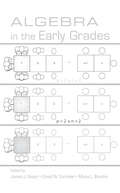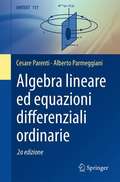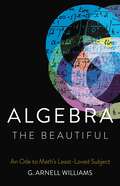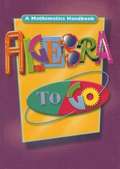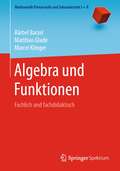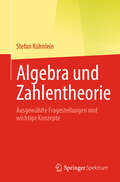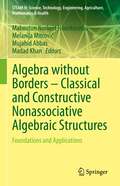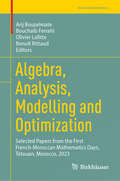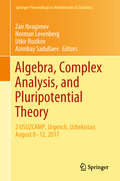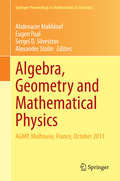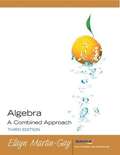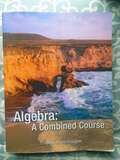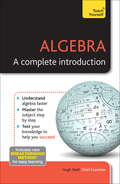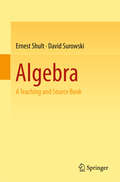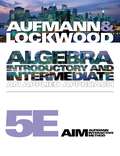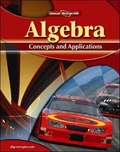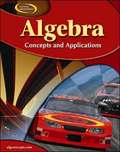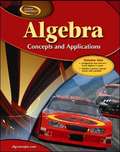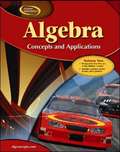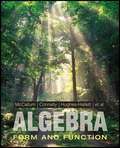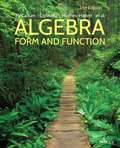- Table View
- List View
Algebra für Höhlenmenschen und andere Anfänger: Eine Einführung in die Grundlagen der Mathematik (essentials)
by Jürgen BeetzWissen Sie schon alles über Zahlen? Es gibt gerade, krumme, gebrochene, aber wie viele? Und rechnen Sie immer richtig? Eine jährliche Inflationsrate von 3 Prozent ergibt nach 20 Jahren eine Preissteigerung von 60 Prozent - oder sind es 75 Prozent? Schon Ihre Vorfahren vor 10. 000 Jahren hatten bereits das Denken gelernt. Deswegen beschäftigen sie sich in diesen vergnüglichen Geschichten mit grundlegenden mathematischen Kenntnissen: mit Zahlen und Mengen, dem Rechnen und mathematischen Symbolen, Potenzen und ihren Umkehrungen (den Logarithmen), Klammern und Wurzeln, Zinsen und Prozenten, einfachen Gleichungen und ihrer Manipulation und schließlich mit tiefsinnigen Fragen um die Extreme: die Null und das Unendliche.
Algebra in the Early Grades (Studies in Mathematical Thinking and Learning Series)
by James J. KaputThis volume is the first to offer a comprehensive, research-based, multi-faceted look at issues in early algebra. In recent years, the National Council for Teachers of Mathematics has recommended that algebra become a strand flowing throughout the K-12 curriculum, and the 2003 RAND Mathematics Study Panel has recommended that algebra be “the initial topical choice for focused and coordinated research and development [in K-12 mathematics].” This book provides a rationale for a stronger and more sustained approach to algebra in school, as well as concrete examples of how algebraic reasoning may be developed in the early grades. It is organized around three themes: The Nature of Early Algebra Students’ Capacity for Algebraic Thinking Issues of Implementation: Taking Early Algebra to the Classrooms. The contributors to this landmark volume have been at the forefront of an effort to integrate algebra into the existing early grades mathematics curriculum. They include scholars who have been developing the conceptual foundations for such changes as well as researchers and developers who have led empirical investigations in school settings. Algebra in the Early Grades aims to bridge the worlds of research, practice, design, and theory for educators, researchers, students, policy makers, and curriculum developers in mathematics education.
Algebra lineare ed equazioni differenziali ordinarie (UNITEXT #117)
by Cesare Parenti Alberto ParmeggianiLa prima parte del presente volume fornisce strumenti dell'algebra lineare nel caso finito dimensionale, ma con la prospettiva infinito-dimensionale, giungendo a trattare argomenti quali funzioni di matrice, equazioni matriciali e matrici dipendenti da parametri.La seconda parte tratta di equazioni/sistemi differenziali ordinari, con particolare enfasi sulla stabilità dei punti di equilibrio e delle orbite periodiche (per esempio il Teorema di Poincaré).Non mancano applicazioni alle equazioni alle derivate parziali (metodo delle caratteristiche ed equazione di Hamilton-Jacobi).La prima parte può essere utilizzata autonomamente, mentre la seconda dipende in parte dai risultati esposti nella prima.Nel testo sono presenti esercizi in forma di verifica di proprietà indicate e, alla fine di ciascuna parte, esercizi volti alla verifica della comprensione degli argomenti trattati ed esercizi riguardanti possibili generalizzazioni.Si tratta di un testo avanzato, rivolto a studenti della laurea magistrale o del dottorato di ricerca.
Algebra the Beautiful: An Ode to Math's Least-Loved Subject
by G. Arnell WilliamsA mathematician reveals the hidden beauty, power, and—yes—fun of algebra What comes to mind when you think about algebra? For many of us, it&’s memories of dull or frustrating classes in high school. Award-winning mathematics professor G. Arnell Williams is here to change that. Algebra the Beautiful is a journey into the heart of fundamental math that proves just how amazing this subject really is. Drawing on lessons from twenty-five years of teaching mathematics, Williams blends metaphor, history, and storytelling to uncover algebra&’s hidden grandeur. Whether you&’re a teacher looking to make math come alive for your students, a parent hoping to get your children engaged, a student trying to come to terms with a sometimes bewildering subject, or just a lover of mathematics, this book has something for you. With a passion that&’s contagious, G. Arnell Williams shows how each of us can grasp the beauty and harmony of algebra.
Algebra to Go: A Mathematics Handbook
by Great Source Education GroupAlgebra to Go is a reference book, providing explanations, charts, graphs, and numerous examples to help students understand and retain algebraic concepts.
Algebra und Funktionen: Fachlich und fachdidaktisch (Mathematik Primarstufe und Sekundarstufe I + II)
by Bärbel Barzel Marcel Klinger Matthias Glade„Algebra und Funktionen hatte ich ja schon in der Schule, aber was muss man dazu als Lehrkraft wissen?“ – Im Kontext der Lehramtsausbildung ist es notwendig diese „elementaren“ Inhalte der Sekundarstufe I tiefer zu durchdringen, sicher zu beherrschen und das für das Lehren und Lernen relevante fachdidaktische Wissen zu entwickeln. Hierzu bietet das Buch Unterstützung und das nötige Hintergrundwissen. Das Werk knüpft dabei an die Erfahrungen der Leserschaft an, ermöglicht eigene Erkundungen sowie vielfältiges Üben, verbindet verschiedene Wege und Darstellungen systematisch miteinander und erlaubt dadurch eine gesamtheitliche Verstehensorientierung. Gleichzeitig wird ein vernetzender, allgemeinerer Blick „von oben“ angeregt, indem Funktionstypen verglichen und übergreifende fachliche und fachdidaktische Konzepte wie das Verknüpfen von Funktionen, das Modellieren mit und Grundvorstellungen von Funktionen herausgearbeitet werden, die es ermöglichen die Inhalte tiefer zu durchdringen und zu reflektieren. Abgerundet wird das Angebot durch Checklisten, ausführliche Lösungen zu den Übungsaufgaben und digitale Applets auf der Internetseite zum Buch, die ein erfolgreiches Arbeiten mit den Inhalten unterstützen.Entsprechende Inhalte finden Sie auf der Website zum Buch algebra-und-funktionen.de. Das Buch richtet sich an Lehramtsstudierende, berufserfahrene Mathematiklehrkräfte und solche im Vorbereitungsdienst, aber insbesondere auch an Fachfremde und Lehrkräfte im Seiteneinstieg.
Algebra und Zahlentheorie: Ausgewählte Fragestellungen und wichtige Konzepte
by Stefan KühnleinBeginnend mit einer ausführlichen Diskussion der Primfaktorzerlegung natürlicher Zahlen werden die grundlegenden algebraischen Strukturen, also Gruppen, Ringe und Körper, eingeführt und anhand von Beispielen veranschaulicht. Mit fortschreitender algebraischer Entwicklung kehrt der Text zu zahlentheoretischen Fragestellungen zurück, wobei weitere Themen der Schulmathematik in den abstrakten Rahmen eingebettet werden, der dadurch eine greifbarere Bedeutung erhält. Einige Erkenntnisse, die zuvor aufwendig erarbeitet wurden, werden durch den Einsatz abstrakterer Argumente besser strukturiert und einfacher begründet. Im abschließenden Kapitel werden Körpererweiterungen und die Galoistheorie behandelt, mit deren Hilfe dann insbesondere die Konstruierbarkeit geometrischer Figuren mit Zirkel und Lineal sowie die Frage nach Lösungsformeln für Polynomgleichungen erneut untersucht und zu einem gewissen Abschluss gebracht werden. Das Buch wendet sich an Leser und Leserinnen, die Interesse an mathematischen Fragestellungen mitbringen und mit mengentheoretischer Notation, mit Beweistechniken sowie idealerweise mit elementaren Aspekten der Vektorraumtheorie vertraut sind.
Algebra without Borders – Classical and Constructive Nonassociative Algebraic Structures: Foundations and Applications (STEAM-H: Science, Technology, Engineering, Agriculture, Mathematics & Health)
by Mujahid Abbas Mahouton Norbert Hounkonnou Melanija Mitrović Madad KhanThis book gathers invited, peer-reviewed works presented at the 2021 edition of the Classical and Constructive Nonassociative Algebraic Structures: Foundations and Applications—CaCNAS: FA 2021, virtually held from June 30 to July 2, 2021, in dedication to the memory of Professor Nebojša Stevanović (1962-2009). The papers cover new trends in the field, focusing on the growing development of applications in other disciplines. These aspects interplay in the same cadence, promoting interactions between theory and applications, and between nonassociative algebraic structures and various fields in pure and applied mathematics.In this volume, the reader will find novel studies on topics such as left almost algebras, logical algebras, groupoids and their generalizations, algebraic geometry and its relations with quiver algebras, enumerative combinatorics, representation theory, fuzzy logic and foundation theory, fuzzy algebraic structures, group amalgams, computer-aided development and transformation of the theory of nonassociative algebraic structures, and applications within natural sciences and engineering.Researchers and graduate students in algebraic structures and their applications can hugely benefit from this book, which can also interest any researcher exploring multi-disciplinarity and complexity in the scientific realm.
Algebra, Analysis, Modelling and Optimization: Selected Papers from the First French-Moroccan Mathematics Days, Tétouan, Morocco, 2023 (Trends in Mathematics)
by Arij Bouzelmate Bouchaib Ferrahi Olivier Lafitte Benoît RittaudThis volume features selected papers presented at the first French-Moroccan Mathematics Days (F2MDays'23) held at the Abdelmalek Essaadi University, Morocco 2023. During these days, a variety of scientific activities involving training, workshops, and international conferences on scientific mediation, applied mathematics, innovation, and didactics of mathematics where held. The event provided an opportunity to build bridges between mathematical communities, reinforce existing international cooperation, and initiate new ones, hence contributing to the outreach of all involved parties.
Algebra, Complex Analysis, and Pluripotential Theory: 2 USUZCAMP, Urgench, Uzbekistan, August 8–12, 2017 (Springer Proceedings in Mathematics & Statistics #264)
by Zair Ibragimov Norman Levenberg Utkir Rozikov Azimbay SadullaevThis book features papers presented during a special session on algebra, functional analysis, complex analysis, and pluripotential theory. Research articles focus on topics such as slow convergence, spectral expansion, holomorphic extension, m-subharmonic functions, pseudo-Galilean group, involutive algebra, Log-integrable measurable functions, Gibbs measures, harmonic and analytic functions, local automorphisms, Lie algebras, and Leibniz algebras. Many of the papers address the theory of harmonic functions, and the book includes a number of extensive survey papers. Graduate and researchers interested in functional analysis, complex analysis, operator algebras and non-associative algebras will find this book relevant to their studies. The special session was part of the second USA-Uzbekistan Conference on Analysis and Mathematical Physics held on August 8-12, 2017 at Urgench State University (Uzbekistan). The conference encouraged communication and future collaboration among U.S. mathematicians and their counterparts in Uzbekistan and other countries. Main themes included algebra and functional analysis, dynamical systems, mathematical physics and partial differential equations, probability theory and mathematical statistics, and pluripotential theory. A number of significant, recently established results were disseminated at the conference’s scheduled plenary talks, while invited talks presented a broad spectrum of findings in several sessions. Based on a different session from the conference, Differential Equations and Dynamical Systems is also published in the Springer Proceedings in Mathematics & Statistics Series.
Algebra, Geometry and Mathematical Physics: AGMP, Mulhouse, France, October 2011 (Springer Proceedings in Mathematics & Statistics #85)
by Abdenacer Makhlouf Eugen Paal Sergei D. Silvestrov Alexander StolinThis book collects the proceedings of the Algebra, Geometry and Mathematical Physics Conference, held at the University of Haute Alsace, France, October 2011. Organized in the four areas of algebra, geometry, dynamical symmetries and conservation laws and mathematical physics and applications, the book covers deformation theory and quantization; Hom-algebras and n-ary algebraic structures; Hopf algebra, integrable systems and related math structures; jet theory and Weil bundles; Lie theory and applications; non-commutative and Lie algebra and more. The papers explore the interplay between research in contemporary mathematics and physics concerned with generalizations of the main structures of Lie theory aimed at quantization and discrete and non-commutative extensions of differential calculus and geometry, non-associative structures, actions of groups and semi-groups, non-commutative dynamics, non-commutative geometry and applications in physics and beyond. The book benefits a broad audience of researchers and advanced students.
Algebra: A Combined Course: Concepts With Applications
by Charles P. McKeagueA Combined Course: Concepts With Applications
Algebra: A Complete Introduction (Teach Yourself)
by Hugh Neill P. AbbottAlgebra: A Complete Introduction is the most comprehensive yet easy-to-use introduction to using Algebra. Written by a leading expert, this book will help you if you are studying for an important exam or essay, or if you simply want to improve your knowledge. <P><P>The book covers all the key areas of algebra including elementary operations, linear equations, formulae, simultaneous equations, quadratic equations, logarithms, variation, laws and sequences.<P>Everything you will need is here in this one book. Each chapter includes not only an explanation of the knowledge and skills you need, but also worked examples and test questions.
Algebra: A Complete Introduction (Teach Yourself)
by Hugh Neill P. AbbottAlgebra: A Complete Introduction is the most comprehensive yet easy-to-use introduction to using Algebra.<P><P>Written by a leading expert, this book will help you if you are studying for an important exam or essay, or if you simply want to improve your knowledge. The book covers all the key areas of algebra including elementary operations, linear equations, formulae, simultaneous equations, quadratic equations, logarithms, variation, laws and sequences.Everything you will need is here in this one book. <P>Each chapter includes not only an explanation of the knowledge and skills you need, but also worked examples and test questions.Chapter 1: The meaning of algebra; Chapter 2: Elementary operations in algebra; Chapter 3: Brackets and operations with them; Chapter 4: Positive and negative numbers; Chapter 5: Equations and expressions; Chapter 6: Linear equations;Chapter 7: Formulae; Chapter 8: Simultaneous equations;Chapter 9: Linear inequalities;Chapter 10: Straight-line graphs; coordinates;Chapter 11: Using inequalities to define regions;Chapter 12: Multiplying algebraical expressions Chapter 13: Factors;Chapter 14: Fractions;Chapter 15: Graphs of quadratic functions;Chapter 16: Quadratic equations;Chapter 17: Indices;Chapter 18: Logarithms;Chapter 19: Ratio and proportion;Chapter 20: Variation;Chapter 21: The determination of laws;Chapter 22: Rational and irrational numbers and surds; Chapter 23: Arithmetical and geometric sequences
Algebra: A Computational Introduction (Studies in Advanced Mathematics)
by John Scherk<p>Adequate texts that introduce the concepts of abstract algebra are plentiful. None, however, are more suited to those needing a mathematical background for careers in engineering, computer science, the physical sciences, industry, or finance than Algebra: A Computational Introduction. Along with a unique approach and presentation, the author demonstrates how software can be used as a problem-solving tool for algebra. A variety of factors set this text apart. Its clear exposition, with each chapter building upon the previous ones, provides greater clarity for the reader. The author first introduces permutation groups, then linear groups, before finally tackling abstract groups. He carefully motivates Galois theory by introducing Galois groups as symmetry groups. He includes many computations, both as examples and as exercises. All of this works to better prepare readers for understanding the more abstract concepts. <p>By carefully integrating the use of Mathematica throughout the book in examples and exercises, the author helps readers develop a deeper understanding and appreciation of the material. The numerous exercises and examples along with downloads available from the Internet help establish a valuable working knowledge of Mathematica and provide a good reference for complex problems encountered in the field.</p>
Algebra: A Teaching and Source Book
by Ernest Shult David SurowskiThis book presents a graduate-level course on modern algebra. It can be used as a teaching book - owing to the copious exercises - and as a source book for those who wish to use the major theorems of algebra. The course begins with the basic combinatorial principles of algebra: posets, chain conditions, Galois connections, and dependence theories. Here, the general Jordan-Holder Theorem becomes a theorem on interval measures of certain lower semilattices. This is followed by basic courses on groups, rings and modules; the arithmetic of integral domains; fields; the categorical point of view; and tensor products. Beginning with introductory concepts and examples, each chapter proceeds gradually towards its more complex theorems. Proofs progress step-by-step from first principles. Many interesting results reside in the exercises, for example, the proof that ideals in a Dedekind domain are generated by at most two elements. The emphasis throughout is on real understanding as opposed to memorizing a catechism and so some chapters offer curiosity-driven appendices for the self-motivated student.
Algebra: An Applied Approach, Fifth Edition
by Richard N. Aufmann Joanne S. LockwoodIn the fifth edition of Algebra: Introductory and Intermediate, the focus remains on the Aufmann Interactive Method (AIM), as in the previous editions. Students are encouraged to be active participants in the classroom and in their own studies as they work through the How To examples and the paired Examples and You Try It problems. All lessons, exercise sets, tests, and supplements are organized around a carefully constructed hierarchy of objectives. This "objective-based" approach not only serves the needs of students, in terms of helping them to clearly organize their thoughts around the content, but instructors as well, as they work to design syllabi, lesson plans, and other administrative documents.
Algebra: Concepts and Applications
by Carol Malloy Jack Price Jerry Cummins Kay Mcclain Yvonne MojicaAn ideal program for struggling students "Glencoe Algebra: Concepts and Applications" covers all the Algebra 1 concepts. This program is designed for students who are challenged by high school mathematics.
Algebra: Concepts and Applications
by Glencoe McGraw-Hill StaffAn ideal program for struggling students Glencoe Algebra: Concepts and Applications covers all the Algebra 1 concepts. This program is designed for students who are challenged by high school mathematics.
Algebra: Concepts and Applications (Volume One)
by Carol Malloy Jack Price Jerry Cummins Kay Mcclain Yvonne MojicaAlgebra: Concepts & Applications, is a comprehensive Algebra 1 program that is available in full and two-volume editions. Algebra: Concepts & Applications uses a clean lesson design with many detailed examples and straightforward narration that make Algebra 1 topics inviting and Algebra 1 content understandable. Volume 1 contains Chapters 1-8 of Algebra: Concepts & Applications plus an initial section called Chapter A. Chapter A includes a pretest, lessons on prerequisite concepts, and a post test. Designed for students who are challenged by high school mathematics, the 2006 edition has many new features and support components.<P> <i>Advisory: Bookshare has learned that this book offers only partial accessibility. We have kept it in the collection because it is useful for some of our members. To explore further access options with us, please contact us through the Book Quality link on the right sidebar. Benetech is actively working on projects to improve accessibility issues such as these. </i>
Algebra: Concepts and Applications, Volume Two
by Carol Malloy Jack Price Jerry Cummins Kay Mcclain Yvonne MojicaAlgebra: Concepts & Applications, is a comprehensive Algebra 1 program that is available in full and two-volume editions. Algebra: Concepts & Applicationsuses a clean lesson design with many detailed examples and straightforward narration that make Algebra 1 topics inviting and Algebra 1 content understandable. Volume 1 contains Chapters 1-8 ofAlgebra: Concepts & Applicationsplus an initial section called Chapter A. Chapter A includes a pretest, lessonson prerequisite concepts, and a posttest. Designed for students who are challenged by high school mathematics, the 2007 edition has many new features and support components.
Algebra: Essentials and Applications
by Winston Holt RinehartAlgebra Essentials and Applications is focused, organized, and easy to follow. The program shows your students how to read, write, and understand the unique language of mathematics, so that they are prepared for every type of problem-solving and assessment situation.
Algebra: Form And Function
by Eric Connally Deborah Hughes-Hallett William G. MccallumThis book offers a fresh approach to algebra that focuses on teaching readers how to truly understand the principles, rather than viewing them merely as tools for other forms of mathematics. It relies on a storyline to form the backbone of the chapters and make the material more engaging. Conceptual exercise sets are included to show how the information is applied in the real world. Using symbolic notation as a framework, business professionals will come away with a vastly improved skill set.
Algebra: Form and Function (Second Edition)
by Eric Connally Elliot J. Marks Pat Shure Carl Swenson Deborah Hughes-Hallett Philip Cheifetz Ann Davidian Brigitte Lahme Patti Frazer Lock William G. Mccallum David Lovelock Ellen Schmierer Aysegul Sahin Adam H. Spiegler Selin KalaycýoðluAlgebra: Form and Function offers a fresh approach to algebra that focuses on teaching readers how to truly understand the principles, rather than viewing them merely as tools for other forms of mathematics. Meant for a College Algebra course, Algebra: Form and Function is an introduction to one of the fundamental aspects of modern society. Algebraic equations describe the laws of science, the principles of engineering, and the rules of business. The power of algebra lies in the efficient symbolic representation of complex ideas, which also presents the main difficulty in learning it. It is easy to forget the underlying structure of algebra and rely instead on a surface knowledge of algebraic manipulations. Most students rely on surface knowledge of algebraic manipulations without understanding the underlying structure of algebra that allows them to see patterns and apply it to multiple situations: McCallum focuses on the structure from the start.

